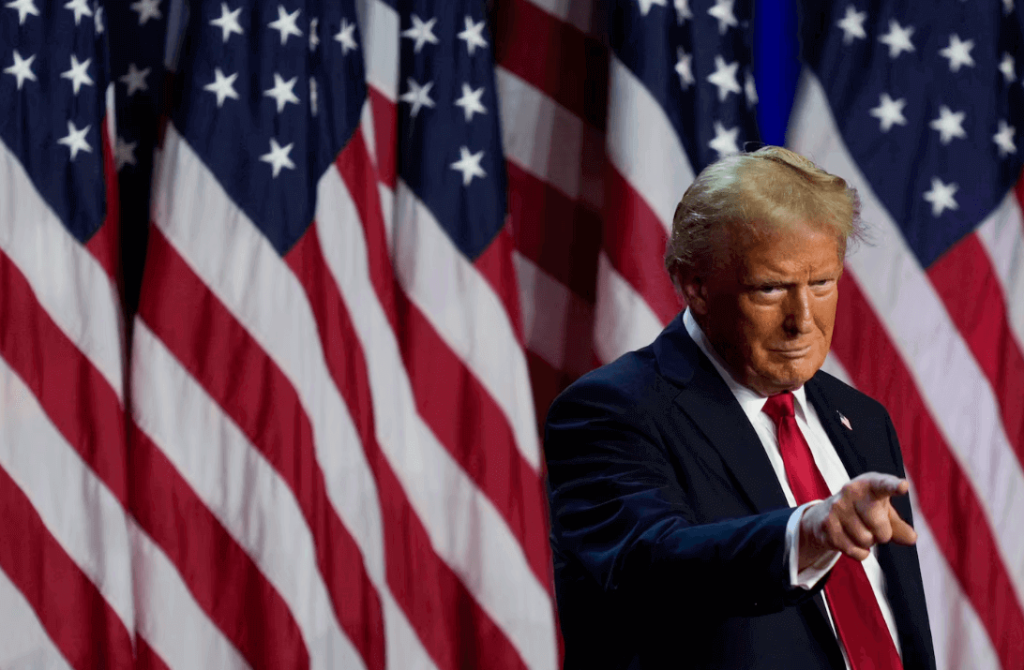【中美创新时报2024 年 11 月 6 日编译讯】(记者温友平编译)唐纳德·特朗普承诺在第二届政府中采取全面行动。美联社记者比尔·巴罗对此作了下述详细报道。
这位前总统、现任总统当选人经常跳过细节,但通过一年多的政策声明和书面声明,概述了一项广泛的议程,将传统的保守派税收、监管和文化问题方法与更民粹的贸易倾向和美国国际角色的转变融合在一起。
特朗普的议程还将缩减联邦政府在民权方面的努力并扩大总统权力。
看看特朗普提出的建议:
移民
“建墙!” 2016 年竞选期间,特朗普的竞选纲领变成了创建“历史上最大的大规模驱逐计划”。特朗普呼吁动用国民警卫队,并授权国内警察部队参与这项行动。不过,特朗普对该计划的具体内容以及如何确保该计划只针对非法入境者却只字未提。他提出了对潜在入境者进行“意识形态筛查”、取消出生公民权(这几乎肯定需要修改宪法)的建议,并表示将恢复第一任期政策,例如“留在墨西哥”、以公共卫生为由限制移民、严格限制或禁止某些穆斯林占多数国家的入境者。总之,这种方法不仅会打击非法移民,而且会全面遏制移民。
堕胎
特朗普淡化了堕胎作为第二任期优先事项的重要性,尽管他因最高法院终止妇女终止妊娠的联邦权利并将堕胎监管权交还给州政府而受到赞扬。在特朗普的坚持下,共和党纲领几十年来首次没有呼吁全国性堕胎禁令。特朗普坚持认为,在联邦层面推翻罗诉韦德案就足够了。
不过,特朗普并没有明确表示,如果全国性堕胎禁令送到他的办公桌上,他会否决。反堕胎活动人士指出,共和党纲领仍然主张胎儿应该根据第十四修正案的平等保护条款获得正当程序保护,这是保守派运动在有特朗普或没有特朗普的情况下可能继续前进的一个例子。这一宪法论点是保守派通过联邦法院寻求全国性堕胎禁令的路线图。
税收
特朗普的税收政策普遍倾向于企业和富裕的美国人。这主要是因为他承诺延长 2017 年的税收改革,其中包括将企业所得税税率从目前的 21% 降至 15%。这还包括撤销民主党总统乔·拜登对最富有的美国人征收的所得税,并废除为应对气候变化的能源措施提供资金的《通货膨胀削减法案》征税。
尽管有这些政策,特朗普还是更加重视针对工薪阶层和中产阶级美国人的新提案:免除小费、社会保障工资和加班工资的所得税。然而,值得注意的是,他的小费提案可能会给高收入者提供后门税收减免,这取决于国会如何起草,允许他们将部分工资重新归类为小费收入——在最极端的情况下,对冲基金经理或顶级律师可能会利用特朗普为餐厅服务员、调酒师和其他服务人员设计的政策。
关税和贸易
特朗普对国际贸易的态度是不相信世界市场会损害美国利益。他提议对外国商品征收 10% 至 20% 的关税——在一些演讲中,他甚至提到了更高的百分比。他承诺将重新执行 2020 年 8 月的一项行政命令,要求美国食品和药物管理局只从美国公司购买“基本”药物。他承诺阻止中国买家购买美国“任何重要基础设施”。
DEI、LGBTQ 和民权
特朗普呼吁减少社会对多样性的重视,并为 LGBTQ 公民提供法律保护。特朗普呼吁结束政府机构的多样性、公平和包容性计划,利用联邦资金作为筹码。
在跨性别权利方面,特朗普承诺要全面结束“男孩参与女孩运动”的现象,尽管没有证据,他坚称这种做法十分普遍。但他的政策远远超出了他在集会演讲中赢得的掌声。除其他想法外,特朗普还将撤销拜登政府将《第九条》民权保护扩大到跨性别学生的政策,并要求国会规定出生时只能承认两种性别。
监管、联邦官僚机构和总统权力
这位当选总统寻求减少联邦官僚和监管在经济部门的作用。特朗普将所有监管削减都描述为经济魔杖。他承诺通过消除化石燃料生产的障碍,包括开放所有联邦土地进行勘探,大幅降低美国家庭的水电费——尽管美国的能源产量已经创下历史新高。特朗普承诺通过削减监管来释放住房建设——尽管大多数建筑规则来自州和地方政府。他还表示,他将结束“来自环境极端分子的无聊诉讼”。
这种方法将在许多方面加强行政部门的影响力。这种权力将更直接地来自白宫。
他将把数千名联邦工作人员归类为不受公务员保护的人员,从而使解雇联邦工作人员变得更加容易。这可能会削弱政府执行法规和规则的权力,减少从事这项工作的雇员数量,并可能对留下来的人产生寒蝉效应。
特朗普还声称,即使国会拨款,总统也拥有控制联邦支出的专属权力。特朗普认为,立法者的预算行动“设定了支出上限”,但没有设定下限——这意味着总统“忠实执行法律”的宪法义务包括是否花钱的自由裁量权。这种解释可能会引发与国会的官司。
作为候选人,他还建议,美联储这个设定利率的独立机构应该受到总统更多权力的约束。尽管他没有提供细节,但任何此类举措都将代表美国经济和货币体系运作方式的重大变化。
教育
在特朗普第二届政府中,联邦教育部将成为被取消的目标。这并不意味着特朗普希望华盛顿退出课堂。除了其他策略外,他仍提议利用联邦资金作为筹码,向 K-12 学校系统施压,要求其废除终身制,采用教师绩效工资,并废除各级教育的多元化计划。他呼吁撤回“任何向我们的孩子推行批判种族理论、性别意识形态或其他不适当的种族、性或政治内容的学校或计划”的联邦资金。
在高等教育方面,特朗普提议接管大学的认证程序,他将此举描述为对抗“马克思主义狂热分子和疯子”的“秘密武器”,他声称这些“马克思主义狂热分子和疯子”控制着高等教育。特朗普瞄准了高等教育捐赠基金,称他将通过“对不遵守其法令的学校征税、罚款和起诉过大的私立大学捐赠基金”的方式从学校收取“数十亿美元”。这几乎肯定会以旷日持久的法律斗争告终。
与其他政策领域一样,特朗普实际上并没有提议限制联邦政府在高等教育领域的权力,而是加强了它。他呼吁将没收的捐赠资金重新投入到在线“美国学院”,向所有美国人提供免学费的大学文凭。特朗普在 2023 年 11 月 1 日表示:“这将是严格非政治性的,不会允许任何觉醒或圣战主义——所有这些都不会被允许。”
社会保障、医疗保险和医疗补助
特朗普坚称他将保护社会保障和医疗保险,这两个项目面向老年美国人,是每年联邦支出中最大的一块。有人质疑,他提出的不对小费和加班工资征税的提议会如何影响社会保障和医疗保险。如果这些计划最终只涉及所得税,那么福利计划将不会受到影响。但免除这些工资的工资税将减少社会保障和医疗保险支出的资金流。特朗普很少谈论医疗补助计划,但他的第一届政府总体上默认批准各州对各种联邦规则的豁免请求,并广泛认可州一级对受助人的工作要求。
平价医疗法案和医疗保健
自 2015 年以来,特朗普一直呼吁废除平价医疗法案及其补贴医疗保险市场。但他仍未提出替代方案:在 9 月的辩论中,他坚称自己有“计划概念”。在竞选的后期,特朗普大肆宣传他与前总统候选人小罗伯特·肯尼迪 (Robert F. Kennedy Jr.) 的联盟,后者长期批评疫苗和美国农业使用的杀虫剂。特朗普多次告诉集会人群,他会让肯尼迪负责“让美国恢复健康”。
气候和能源
特朗普错误地声称气候变化是一个“骗局”,他抨击拜登时代为减少美国对化石燃料的依赖而对清洁能源的支出。他提出了一项以化石燃料为基础的能源政策和交通基础设施支出:道路、桥梁和内燃机汽车。“钻吧,宝贝,钻吧!”是特朗普集会上的常见口号。特朗普表示,他并不反对电动汽车,但承诺终止拜登为鼓励电动汽车市场发展而提供的所有激励措施。特朗普还承诺撤销拜登时代的燃油效率标准。
工人权利
特朗普和当选副总统 JD Vance 将他们的竞选纲领定性为有利于美国工人。但特朗普可能会让工人更难成立工会。在讨论汽车工人时,特朗普几乎只关注拜登推动电动汽车的发展。当他提到工会时,他经常把“工会老板和首席执行官”归为一类,认为他们是“这场灾难性的电动汽车计划”的同谋。在 2023 年 10 月 23 日的一份声明中,特朗普谈到全美汽车工人联合会时说:“我告诉你,你不应该支付这些会费。”
国防和美国在世界上的角色
特朗普在世界事务中的言论和政策方针在外交上比美国二战以来更加孤立主义,在军事上更不干涉,在经济上更保护主义。但细节更加复杂。他承诺扩大军事力量,保证保护五角大楼的开支不受紧缩政策的影响,并提出建立新的导弹防御系统——这是冷战期间里根时代的一个老想法。特朗普坚称他可以结束俄罗斯在乌克兰的战争和以色列与哈马斯的战争,但没有解释如何做到这一点。特朗普用里根的另一句话总结了他的做法:“以实力求和平”。但他仍然批评北约和美国军方高层。特朗普在谈到美国人“在电视上看到的”五角大楼官员时说:“我不认为他们是领导人。”他多次称赞匈牙利的维克托·奥尔班和俄罗斯的弗拉基米尔·普京等独裁者。
题图:共和党总统候选人、前总统唐纳德·特朗普于 11 月 6 日在佛罗里达州西棕榈滩举行的选举之夜观察会上向人群指着。Julia Demaree Nikhinson/美联社
附原英文报道:
Donald Trump has sweeping plans for a second administration. Here’s what he’s proposed.
By BILL BARROW The Associated Press,Updated November 6, 2024
Republican presidential nominee former President Donald Trump points to the crowd at an election night watch party on Nov. 6 in West Palm Beach, Fla.Julia Demaree Nikhinson/Associated Press
WASHINGTON — Donald Trump has promised sweeping action in a second administration.
The former president and now president-elect often skipped over details but through more than a year of policy pronouncements and written statements outlined a wide-ranging agenda that blends traditional conservative approaches to taxes, regulation and cultural issues with a more populist bent on trade and a shift in America’s international role.
Trump’s agenda also would scale back federal government efforts on civil rights and expand presidential powers.
A look at what Trump has proposed:
Immigration
“Build the wall!” from his 2016 campaign has become creating “the largest mass deportation program in history.” Trump has called for using the National Guard and empowering domestic police forces in the effort. Still, Trump has been scant on details of what the program would look like and how he would ensure that it targeted only people in the US illegally. He’s pitched “ideological screening” for would-be entrants, ending birth-right citizenship (which almost certainly would require a constitutional change), and said he’d reinstitute first-term policies such as “Remain in Mexico,” limiting migrants on public health grounds and severely limiting or banning entrants from certain majority-Muslim nations. Altogether, the approach would not just crack down on illegal migration, but curtail immigration overall.
Abortion
Trump played down abortion as a second-term priority, even as he took credit for the Supreme Court ending a woman’s federal right to terminate a pregnancy and returning abortion regulation to state governments. At Trump’s insistence, the GOP platform, for the first time in decades, did not call for a national ban on abortion. Trump maintains that overturning Roe v. Wade is enough on the federal level.
Still, Trump has not said explicitly that he would veto national abortion restrictions if they reached his desk. And in an example of how the conservative movement might proceed with or without Trump, anti-abortion activists note that the GOP platform still asserts that a fetus should have due process protections under the 14th Amendment’s equal protection clause. That constitutional argument is a roadmap for conservatives to seek a national abortion ban through federal courts.
Taxes
Trump’s tax policies broadly tilt toward corporations and wealthier Americans. That’s mostly due to his promise to extend his 2017 tax overhaul, with a few notable changes that include lowering the corporate income tax rate to 15 percent from the current 21 percent. That also involves rolling back Democratic President Joe Biden’s income tax hikes on the wealthiest Americans and scrapping Inflation Reduction Act levies that finance energy measures intended to combat climate change.
Those policies notwithstanding, Trump has put more emphasis on new proposals aimed at working- and middle class Americans: exempting earned tips, Social Security wages and overtime wages from income taxes. It’s noteworthy, however, that his proposal on tips, depending on how Congress might write it, could give a back-door tax break to top wage earners by allowing them to reclassify some of their pay as tip income — a prospect that at its most extreme could see hedge-fund managers or top-flight attorneys taking advantage of a policy that Trump frames as being designed for restaurant servers, bartenders and other service workers.
Tariffs and trade
Trump’s posture on international trade is to distrust world markets as harmful to American interests. He proposes tariffs of 10 percent to 20 percent on foreign goods — and in some speeches has mentioned even higher percentages. He promises to reinstitute an August 2020 executive order requiring that the Food and Drug Administration buy “essential” medications only from US companies. He pledges to block purchases of “any vital infrastructure” in the US by Chinese buyers.
DEI, LGBTQ and civil rights
Trump has called for rolling back societal emphasis on diversity and for legal protections for LGBTQ citizens. Trump has called for ending diversity, equity and inclusion programs in government institutions, using federal funding as leverage.
On transgender rights, Trump promises generally to end “boys in girls’ sports,” a practice he insists, without evidence, is widespread. But his policies go well beyond standard applause lines from his rally speeches. Among other ideas, Trump would roll back the Biden administration’s policy of extending Title IX civil rights protections to transgender students, and he would ask Congress to require that only two genders can be recognized at birth.
Regulation, federal bureaucracy and presidential power
The president-elect seeks to reduce the role of federal bureaucrats and regulations across economic sectors. Trump frames all regulatory cuts as an economic magic wand. He pledges precipitous drops in US households’ utility bills by removing obstacles to fossil fuel production, including opening all federal lands for exploration — even though US energy production is already at record highs. Trump promises to unleash housing construction by cutting regulations — though most construction rules come from state and local government. He also says he would end “frivolous litigation from the environmental extremists.”
The approach would in many ways strengthen executive branch influence. That power would come more directly from the White House.
He would make it easier to fire federal workers by classifying thousands of them as being outside civil service protections. That could weaken the government’s power to enforce statutes and rules by reducing the number of employees engaging in the work and, potentially, impose a chilling effect on those who remain.
Trump also claims that presidents have exclusive power to control federal spending even after Congress has appropriated money. Trump argues that lawmakers’ budget actions “set a ceiling” on spending but not a floor — meaning the president’s constitutional duty to “faithfully execute the laws” includes discretion on whether to spend the money. This interpretation could set up a court battle with Congress.
As a candidate, he also suggested that the Federal Reserve, an independent entity that sets interest rates, should be subject to more presidential power. Though he has not offered details, any such move would represent a momentous change to how the US economic and monetary systems work.
Education
The federal Department of Education would be targeted for elimination in a second Trump administration. That does not mean that Trump wants Washington out of classrooms. He still proposes, among other maneuvers, using federal funding as leverage to pressure K-12 school systems to abolish tenure and adopt merit pay for teachers and to scrap diversity programs at all levels of education. He calls for pulling federal funding “for any school or program pushing Critical Race Theory, gender ideology, or other inappropriate racial, sexual, or political content on our children.”
In higher education, Trump proposes taking over accreditation processes for colleges, a move he describes as his “secret weapon” against the “Marxist Maniacs and lunatics” he says control higher education. Trump takes aim at higher education endowments, saying he will collect “billions and billions of dollars” from schools via “taxing, fining and suing excessively large private university endowments” at schools that do not comply with his edicts. That almost certainly would end up in protracted legal fights.
As in other policy areas, Trump isn’t actually proposing limiting federal power in higher education but strengthening it. He calls for redirecting the confiscated endowment money into an online “American Academy” offering college credentials to all Americans without a tuition charges. “It will be strictly non-political, and there will be no wokeness or jihadism allowed—none of that’s going to be allowed,” Trump said on Nov. 1, 2023.
Social Security, Medicare and Medicaid
Trump insists he would protect Social Security and Medicare, popular programs geared toward older Americans and among the biggest pieces of the federal spending pie each year. There are questions about how his proposal not to tax tip and overtime wages might affect Social Security and Medicare. If such plans eventually involved only income taxes, the entitlement programs would not be affected. But exempting those wages from payroll taxes would reduce the funding stream for Social Security and Medicare outlays. Trump has talked little about Medicaid but his first administration, in general, defaulted to approving state requests for waivers of various federal rules and it broadly endorsed state-level work requirements for recipients.
Affordable Care Act and Health Care
As he has since 2015, Trump calls for repealing the Affordable Care Act and its subsidized health insurance marketplaces. But he still has not proposed a replacement: In a September debate, he insisted he had the “concepts of a plan.” In the latter stages of the campaign, Trump played up his alliance with former presidential candidate Robert F. Kennedy Jr., a longtime critic of vaccines and of pesticides used in US agriculture. Trump repeatedly told rally crowds that he would put Kennedy in charge of “making America healthy again.”
Climate and energy
Trump, who claims falsely that climate change is a “hoax,” blasts Biden-era spending on cleaner energy designed to reduce US reliance on fossil fuels. He proposes an energy policy – and transportation infrastructure spending – anchored to fossil fuels: roads, bridges and combustion-engine vehicles. “Drill, baby, drill!” was a regular chant at Trump rallies. Trump says he does not oppose electric vehicles but promises to end all Biden incentives to encourage EV market development. Trump also pledges to roll back Biden-era fuel efficiency standards.
Workers’ rights
Trump and Vice President-elect JD Vance framed their ticket as favoring America’s workers. But Trump could make it harder for workers to unionize. In discussing auto workers, Trump focused almost exclusively on Biden’s push toward electric vehicles. When he mentioned unions, it was often to lump “the union bosses and CEOs” together as complicit in “this disastrous electric car scheme.” In an Oct. 23, 2023, statement, Trump said of United Auto Workers, “I’m telling you, you shouldn’t pay those dues.”
National defense and America’s role in the world
Trump’s rhetoric and policy approach in world affairs is more isolationist diplomatically, non-interventionist militarily and protectionist economically than the US has been since World War II. But the details are more complicated. He pledges expansion of the military, promises to protect Pentagon spending from austerity efforts and proposes a new missile defense shield — an old idea from the Reagan era during the Cold War. Trump insists he can end Russia’s war in Ukraine and the Israel-Hamas war, without explaining how. Trump summarizes his approach through another Reagan phrase: “peace through strength.” But he remains critical of NATO and top US military brass. “I don’t consider them leaders,” Trump said of Pentagon officials that Americans “see on television.” He repeatedly praised authoritarians like Hungary’s Viktor Orban and Russia’s Vladimir Putin.

